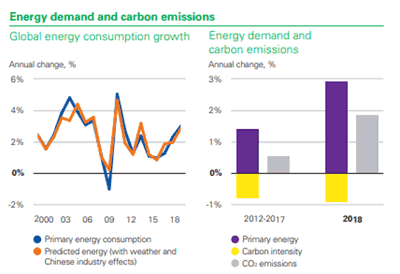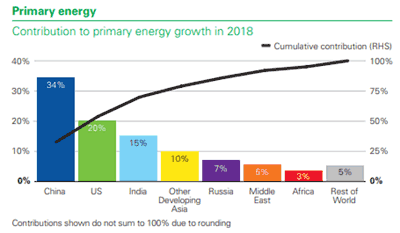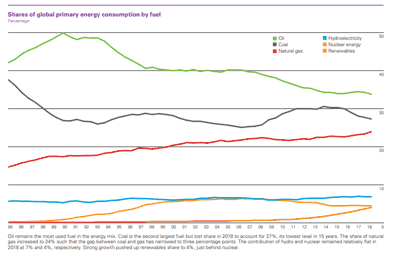 |
September 6, 2019 - Supply Chain Flagship Newsletter |
 |
|
||||||||||
 |
|
||||||||||||||||||||||||||||||||||||||||||||||||||||||||||||||||||||||||||||||||||||||||||||||||||||||||||||||||||||||
|
|||||||||||||||||||||||||||||||||||||||||||||||||||||||||||||||||||||||||||||||||||||||||||||||||||||||||||||||||||||||
This was mostly the result of generally strong economic conditions seen globally last year. For now and the foreseeable future, economic growth, especially in emerging economies, means rising CO2. The next chart looks at which countries represented what share of the growth in energy consumption in 2018. China as usual by far led the pack, responsible for 34% of the total growth in energy consumption. The US was second at 15% - driven again almost 3% economic growth - followed by India at 10% of the total. |
|||||||||||||||||||||||||||||||||||||||||||||||||||||||||||||||||||||||||||||||||||||||||||||||||||||||||||||||||||||||
Surprising to me, other developing Asian countries represented just 10% of the growth. Finally, each year the report shows trends in the share of different energy sources over time, as shown in the graphic below. |
|||||||||||||||||||||||||||||||||||||||||||||||||||||||||||||||||||||||||||||||||||||||||||||||||||||||||||||||||||||||
While oil's share continues to decline, it is still the top source, at about 34%, with the recent declines in share really leveling off. While coal's share is also declining, it remains the number 2 source - still widely used not only in China but Green thinking Europe. Natural gas has picked up share as utilities switch from coal to gas for producing electricity - driven largely by costs, not CO2. And alternative sources? As you can see, hydropower has gone flat, with nuclear continuing to decline after the Japan nuclear disasters a few years back. As for true renewables (wind, solar, bio fuels, etc.), the trend is clearly up but still represent less than 5% of total global energy consumption. Mercedes and cheeseburgers, or lower CO2? A middle path? The 2020 election will be very interesting and consequential indeed. Any reaction to this data on energy and CO2? Let us know your thought at the Feedback button below. |
|||||||||||||||||||||||||||||||||||||||||||||||||||||||||||||||||||||||||||||||||||||||||||||||||||||||||||||||||||||||
|
|
|
YOUR FEEDBACK
Some of the short feedbacks on our recent columns summarizing the 2019 State of Logistics report from CSCMP. Here are a few.
Feedback on State of Logistics Report Coverage.
![]()
SCDigest does an amazing job with this. You take a very long document and boil it down to its essence in just one or two columns.
This is a great service to the industry - thank you.
Michelle Watson
Ft. Wayne, IN

![]()
I agree with you on the timing. By the time the report shows in late June, my interest in 2018 data has faded. We're already starting to look ahead to the next year.
I don't have a magic wand on how this could be changed to get the report out earlier, but it would make it much more valuable.
Mark Fitz
Stow, OH

![]()
It would be very interesting to know logistics costs as a percent of GDP in other countries. Can this be provided?
Amy Danko
Kansas City
Editor's Note:
We'll see what we can do.

![]()
I really like the way you take a long report and break it down into the key statistic. It's a pleasure to read, and I watched the excellent video summary itself on the Video News.
Brian Toomay
Atlanta
SUPPLY CHAIN TRIVIA ANSWER
Q: The Los Angeles, New Jersey, Chicago and Atlanta metro areas have what percent of total US warehouse space?
A: 29%, according to Cushman & Wakefield.
| © SupplyChainDigest™ 2003-2019. All Rights Reserved. SupplyChainDigest PO Box 714 Springboro, Ohio 45066 |
POWERED BY: XDIMENSION
|














